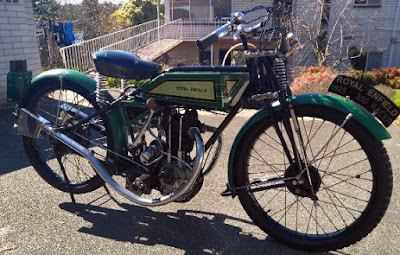 |
| A surviving Royal Enfield Model 352 racer of 1925; it carried a 350cc JAP motor with two exhaust ports. |
By Mick Lemon
Royal Enfield are not well known for their faster high performance machines, but back in the '20s and '30s, things were different. Enfield entered factory teams in the Isle of Man up until 1935 and they manufactured some high performance, technically advanced machines right up until World War II.
There are a group of lucky owners spread over the world who own Royal Enfields made in the 1930s that have four valves and were manufactured for the high end market and/or racing. There was also a three-valve model made for only one year.
During the mid-to-late 1920s Royal Enfield gained some racing credibility — especially in the 250 and 350 classes of racing. JAP engines were used, some having twin exhaust ports and close ratio Sturmey Archer gearboxes.
The top end 350 was known as the Model 352 (the Model 351 had one exhaust port). Successes included winning the Ulster Grand Prix in 1925 and second place in 1926, winning the South African Tourist Trophy races in both the 350 and 600 class.
In 1927 Royal Enfield won the Isle of Man TT Junior class (i.e. 350cc). Manufacturers Team Prize for the first works team with the four team members getting third, sixth, seventh and eighteenth. Well known riders of the day included Stan Woods, Cecil Barrow, Charlie Young and Fred Bricknell.
While Enfield were still using JAP engines, they were busy developing their own engines and some very nice overhead-valve twin-port machines in the 1928-1930 seasons in 250, 350 and 500 capacities, including the Models CO and E.
There was a huge amount of development and experimentation being carried out by the lead manufacturers during this period and benefits to performance were obvious.
The first four-valve machine entered the range in 1931 and was known as the Model JF. The four-valve machines were also often known as the Bullets — a name that is still used by Enfield today. At this time though, the Bullet name was only associated with the sports models.
This bike had the near square-bore dimensions of 85mm X 85.5mm that continued to be used until 1936 for the 500cc bikes and was also used for the 1,000cc V twins. Oil tank integrated into the crankcase castings and the use of the patented Enfield oil pumps came common engine design features through most of the range of models from this time. The four-valve machines were well presented with chrome tanks and instrumentation on a panel in the tank.
In 1932 there was a design upgrade and the Model LF was introduced, having push rod tunnels cast into the cylinder casting and either a three-speed hand change gearbox or a four-speed gearbox foot change.
Options for high compression pistons and factory tuning were available, along with upswept exhaust pipes. The higher spec machine sold for a whole 2 pounds more!
1933 saw a frame design change and well as further engine improvements. One of the major issues with the four-valve engines was the cracking of the cylinder heads when the machines were ridden hard. This occurred between the exhaust ports and was also an issue for other manufacturers. Bronze heads were used on racing machines to reduce the chance of cracking that took place with the cast iron heads.
 |
| A bronze-head Royal Enfield 1934 LF still running and in racing trim. |
The last time Royal Enfield provided a factory team for the Isle of Man was 1935. In that year, a LF ridden by Cecil Barrows came eighth in the Senior event, beaten by Moto Guzzis, DKWs, Nortons and one HRD. The Enfield came in ahead of all other HRDs and all Velocettes. This may surprise many classic bike people. The LF ridden by Cecil in the IOM still survives and is in Europe.
In 1935, the LF was dropped from the range in favour of a three-valve model. The reason was due to the head cracking issues with the four-valve machines. The new model was called the LO and had two inlets and one exhaust valve with fully enclosed valve gear. The performance of the LO was significantly down on the LF and the model was quickly dropped again in favor of a completely new machine in 1936 known as the JF (reverting back to the JF model name).
The new JF was a totally different machine with a vertical engine, replacing the sloper layout, and had a full cradle frame. The head was redesigned yet again and cracking was reduced, although bronze heads were still available as an option for machines used in competition. This model of JF was essentially based on the common J model bike, but was fitted with alternative barrel, head and valve gear, as well as being presented with chrome tank, guards and primary. The model was offered in its own right in 1936 and '37.
 |
| A 1937 Model JF (one of four running JF’s known to exist in Australia). |
Examples of these “multi-valve” Enfields have survived and are located across the globe. There are examples in England, Holland, Finland, Australia, Canada, New Zealand, U.S. and even Guatemala and the Canary Islands!
There is an email group of owners who communicate with each other and assist in the restoration and knowledge base of these machines. If you are lucky enough to own one, have expert knowledge of these machines, or have a keen interest in them, joining the email group may be a worthwhile exercise.
































No comments:
Post a Comment